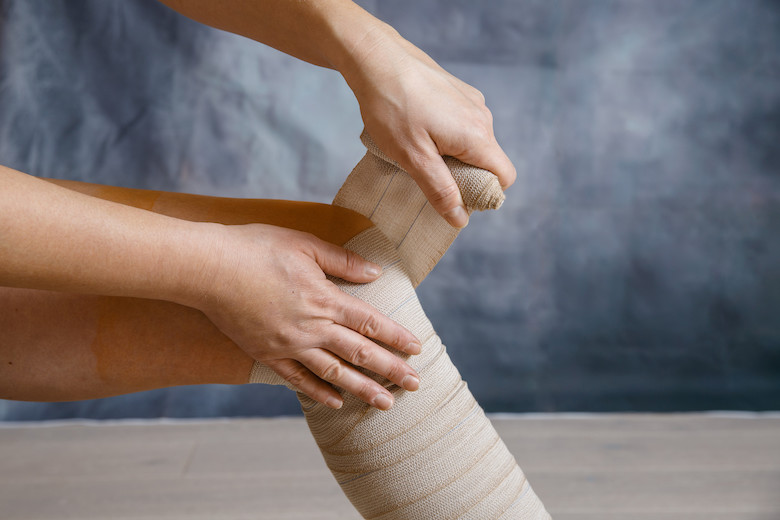Compression Bandaging
Compression Bandaging is a very specific method of applying short-stretch bandaging, foam, and other materials to reduce fluid in an area of the body such as an arm or a leg.
When someone has lymphedema (long-standing swelling that doesn’t resolve on its own) typically compression bandaging is done prior to fitting for long-term compression garment. Bandaging can also be done and then removed during a lymphatic drainage session in order to more quickly facilitate lymphatic drainage.

Regarding people who have Lymphedema, Compression Bandaging Therapy is considered an essential part of Complete Decongestive Therapy (CDT). It is used f0r several weeks until the maximum amount of fluid has been removed from the affected area.
Although it is most commonly known for its effectiveness in Lymphedema, temporary Compression Bandaging is also appropriate for Edema related to injuries and Chronic Venous Insufficiency (CVI).
When a person has swelling, compression generally provides great relief, especially when pain is associated with any of the aforementioned conditions.
Compression Bandaging for Lymphedema Management
In Lymphedema Therapy, compression bandaging is used to reduce the size of the affected limb and essential part of Complete Decongestive Therapy (CDT).
When used together with Manual Lymphatic Drainage (MLD) or Electro-Lymphatic Therapy (ELT), bandaging can significantly improve the degree of fluid reduction achieved in a single session.

Because the lymphatic pathways get opened up with MLD or ELT, they begin flowing readily. Following a lymphatic drainage session with either MLD or ELT, compression is able to encourage more fluid to move out of the affected area long after the session is over.
Compression Bandaging for Chronic Venous Insufficiency
In Chronic Venous Insufficiency valves have failed that keep blood from falling backwards down the leg when the heart is in its resting phase. When blood is allowed to rush backwards, more fluid comes out of the bloodstream into the space around the cells. This is what causes swelling.
Over the long term this excess fluid in the legs causes tissue changes such as darkening of the skin and can progress to leg ulcers that usually appear on the inside of the lower leg. Compression bandaging has been shown to improve the speed of healing wounds that come about as a result of Chronic Venous Insufficiency (CVI).
Compression helps narrow veins and may help restore valve competency, which in turn reduces venous reflux (the back fl0w of blood). Compression also helps to improve lymphatic flow. In short, compression helps to mimic normal circulatory function which speeds the healing of wounds.
Can’t I Just Wrap Myself with an Ace Bandage?

In a word, no – and the reason is very important.
So-called “Ace bandages” that can be purchased at your local pharmacy have very different properties than the bandages used in Complete Decongestive Therapy (CDT) for Lymphedema.
Ace Bandages stretch to 140% of their original length when pulled. They are manufactured with a material called polyurethane.
By contrast, “short stretch bandages,” the kind used in CDT for Lymphedema are made of cotton and are woven so that they only allow 60% of stretch.
Working Pressure vs. Resting Pressure
Working Pressure is a term used to describe the amount of pressure a bandage is providing when a person is moving their muscles under the bandage.
Resting Pressure is the pressure applied by a bandage when a person is being still.
Short Stretch Bandages, the kind that should be used for Lymphedema, have a high working pressure and a low resting pressure. This means that when a person is up and about or exercising, the bandages are actively applying solid pressure to move fluid and reduce the swelling. When that person is resting, the bandages are applying low pressure. That is, enough to keep swelling from worsening, but not so much that it could damage tissues.
Ace bandages, or “long stretch” bandages, have a low working pressure, meaning that they stretch too much when a person is moving and don’t provide enough resistance to be effective in moving fluid. They also have a high resting pressure, which means when a person is resting that the pressure could restrict the flow of lymph and blood in the veins. This can be dangerous, especially if someone falls asleep or has limited sensation in the wrapped area.

